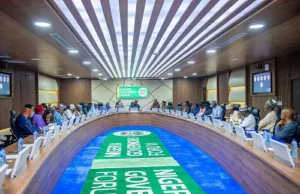The National Transportation Safety Board (NTSB) of the United State has released a preliminary report on the Airbus Helicopter EC130B4 crash which claimed the lives of the Group Managing Director of Access Holdings, Herbert Wigwe, and five others.
This was coming about two weeks after the crash which occurred near Nipton, California around 10 p.m local time.
According to the report sent to the Nigerian Safety Investigation Bureau (NSIB) which has been collaborating with its US counterpart since the crash occurred, during the flight which departed from Bob Hope Airport in Burbank, California to Boulder City Municipal Airport in Nevada via Palm Springs International Airport, “adverse weather conditions characterised by rain and a mix of snow, were encountered, as reported by witnesses.”
Director, Public Affairs and Consumer Protection of NSIB, Mrs Bimbo Oladeji in a statement added that reports from law enforcement and eyewitnesses “also indicated that several individuals travelling along Interstate 15 (I-15) observed a “fireball” in the area, prompting calls to emergency services.”
Also on-board the ill-fated chopper were Wigwe’s wife Doreen and first son, Chizy and Abimbola Ogunbanjo, a former Group Chairman of the Nigerian Exchange (NGX) while the other two were crew members.
The statement said, “Subsequently, the wreckage of the helicopter was discovered in the high, mountainous desert and scrub-brush covered terrain near Halloran Springs, California.
“Analysis of the accident site revealed a scattered debris pattern about 300 ft along a 120° magnetic, indicating a trajectory from an initial impact point which was a 1.5 ft deep, 12 ft long and 10 ft wide ground crater, containing fragments of the right landing gear skid, cockpit wiring, and cabin floor structure. The right skid step protruded upward at a 45° angle at the extreme eastern edge of the ground crater.
“All major helicopter components were identified at the accident site. The helicopter’s fuselage was fragmented, and the cockpit and cabin were destroyed. Some debris and vegetation displayed thermal damage, indicative of the extent of the collision’s force.
“The flight control tubes and linkages leading up to the flight control servos were fragmented and continuity could not be verified. All three pitch control links were attached at the swashplate and blade pitch change horns.
“The main rotor blades were fragmented and broomstrawed, and the blade sleeves and tips were present. Data analysis utilised sources including automatic dependent surveillance-broadcast (ADS-B) data, operator personnel reports, and eyewitness accounts to reconstruct the flight path and sequence of events leading to the accident.”
As the investigation progressed, the NSIB said it remained committed to engaging the NTSB to receive the public docket of the investigation, which will comprise the compendium of information gathered throughout the investigation.
This typically includes photographs, interview summaries, documentation, and other relevant data that will give a clearer picture of the factors that led to the accident.
The Director General of the NSIB Captain Alex Badeh said, “We wish to express our gratitude for the cooperation extended by the NTSB, which has facilitated the sharing of vital information.
“We will continue to work closely with relevant authorities leading the investigation, including the NTSB, to gather additional evidence and information necessary for a comprehensive understanding of the circumstances that led to this tragic event.”










